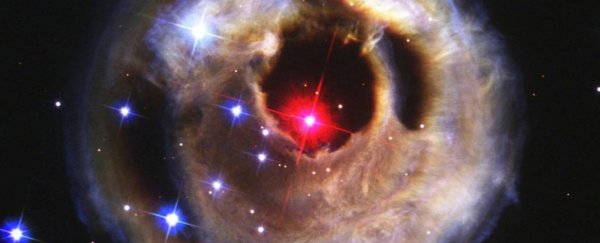An ordinary-looking star system, barely visible in the night sky, appears to have a very bright future in store - and if astronomers' predictions are right, some of us might even be around to see it.
Today, V Sagittae is so faint it's hard to find up there, even with a mid-sized telescope. But over the next few decades, as it's sucked into a nearby white dwarf, all of that could change.
Experts at Louisiana State University (LSU) now think this pair of celestial underdogs is destined to become the most luminous star in the Milky Way galaxy, brighter even than Sirius, which currently holds the top spot.
At least, that is, for a month or so, some 60-odd years from now. As the star and its dwarf companion gradually become one, their merge is set to create the explosion of a lifetime, and it's just around the corner.
"Around the year 2083, its accretion rate will rise catastrophically, spilling mass at incredibly high rates onto the white dwarf, with this material blazing away," says astronomical physicist Bradley Schaefer from LSU.
"In the final days of this death-spiral, all of the mass from the companion star will fall onto the white dwarf, creating a supermassive wind from the merging star, appearing as bright as Sirius, possibly even as bright as Venus."
In fact, the authors think this explosion could end up being the brightest known nova of all-time, nearly as bright as a supernova.
The last time the world experienced something this extreme was just over a century ago, and the V Sge star system is different to this past explosion in more ways than one.
On their own, white dwarfs are merely embers of dying stars, doomed to blaze into invisibility. But when they're in a binary system with a nearby companion star, like V Sge, they can steal enough fuel from their neighbour to survive, however briefly.
This is similar to but not quite the same as a classic nova, which occurs when the white dwarf's surface is heated by a nearby star until runaway nuclear fusion is achieved.
Instead, so-called dwarf novae such as V Sge are known as cataclysmic variables, or CVs, and they are caused when an ordinary star slowly falls into a white dwarf in binary orbit.
In the whole galaxy, there are probably more than a million CVs, but astronomers say V Sge is the most extreme we've seen so far, roughly a hundred times more luminous than all other known examples.
And that's probably because of the companion star's sheer size, which is nearly 4 times bigger than the hungry white dwarf devouring it.
"In all other known CVs the white dwarf is more massive than the orbiting normal star, so V Sge is utterly unique," says Schaefer.
Measuring V Sge's brightness in old sky photos archived in Harvard College Observatory, the team have put together a detailed history of the star going all the way back to the 1890s.
Looking over this timeline, it appears V Sge is spiralling into the dwarf star much faster than we thought, moving ever closer towards a mass transfer of matter that will likely be highly explosive.
Because V Sge is so big, the authors calculate almost all of its gas will have to fall into the dwarf star within the last few weeks and days of the merge, driving a stellar wind larger than anything seen before.
"V Sge is exponentially gaining luminosity with a doubling time scale of 89 years," says astronomer Juhan Frank from LSU.
"This brightening can only result with the rate of mass falling off the normal companion star increasing exponentially, ultimately because the binary orbit is in-spiraling rapidly."
Given some uncertainty around the final date of this remarkable nova, the team thinks the two stars will merge sometime in between 2067 and 2099, which means some of us may actually see it with our own eyes.
"Now people the world over can know that they will see a wondrous guest star shining as the brightest in the sky for a month or so, being pointed at by the Arrow just below Cygnus, the Swan," says Schaefer.
The findings were presented at the 235th American Astronomical Society meeting.
